-
 Bitcoin
Bitcoin $106,754.6083
1.33% -
 Ethereum
Ethereum $2,625.8249
3.80% -
 Tether USDt
Tether USDt $1.0001
-0.03% -
 XRP
XRP $2.1891
1.67% -
 BNB
BNB $654.5220
0.66% -
 Solana
Solana $156.9428
7.28% -
 USDC
USDC $0.9998
0.00% -
 Dogecoin
Dogecoin $0.1780
1.14% -
 TRON
TRON $0.2706
-0.16% -
 Cardano
Cardano $0.6470
2.77% -
 Hyperliquid
Hyperliquid $44.6467
10.24% -
 Sui
Sui $3.1128
3.86% -
 Bitcoin Cash
Bitcoin Cash $455.7646
3.00% -
 Chainlink
Chainlink $13.6858
4.08% -
 UNUS SED LEO
UNUS SED LEO $9.2682
0.21% -
 Avalanche
Avalanche $19.7433
3.79% -
 Stellar
Stellar $0.2616
1.64% -
 Toncoin
Toncoin $3.0222
2.19% -
 Shiba Inu
Shiba Inu $0.0...01220
1.49% -
 Hedera
Hedera $0.1580
2.75% -
 Litecoin
Litecoin $87.4964
2.29% -
 Polkadot
Polkadot $3.8958
3.05% -
 Ethena USDe
Ethena USDe $1.0000
-0.04% -
 Monero
Monero $317.2263
0.26% -
 Bitget Token
Bitget Token $4.5985
1.68% -
 Dai
Dai $0.9999
0.00% -
 Pepe
Pepe $0.0...01140
2.44% -
 Uniswap
Uniswap $7.6065
5.29% -
 Pi
Pi $0.6042
-2.00% -
 Aave
Aave $289.6343
6.02%
What does the secondary enlargement of the MACD red column indicate?
A secondary enlargement of the MACD red column suggests renewed bearish momentum after a brief pause, signaling possible trend continuation or exhaustion in crypto markets.
Jun 16, 2025 at 07:49 pm
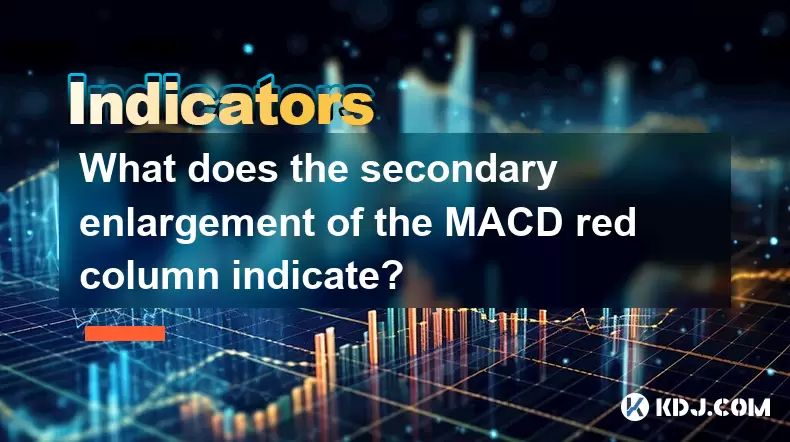
Understanding the MACD Indicator and Its Components
The Moving Average Convergence Divergence (MACD) is a widely used technical analysis tool in cryptocurrency trading. It consists of three main components: the MACD line, the signal line, and the MACD histogram. The histogram, represented as red or green bars, reflects the difference between the MACD line and the signal line. When traders refer to the "secondary enlargement of the MACD red column", they are observing a specific pattern in the histogram that may suggest shifts in market momentum.
The red columns on the MACD histogram indicate that the MACD line is below the signal line, which typically corresponds with a downtrend or bearish sentiment. An initial expansion of the red bar signifies increasing bearish momentum. However, when a secondary enlargement occurs after a brief contraction, it raises questions about whether this is a continuation of the downtrend or an early sign of reversal.
What Constitutes a Secondary Enlargement?
A secondary enlargement of the MACD red column refers to a situation where the red bars initially shrink, suggesting weakening bearish pressure, followed by a sudden increase in the size of the red bars again. This pattern can be broken down into distinct phases:
- A strong downtrend causes the red columns to grow.
- A temporary pause or slight uptick in price leads to smaller red columns, indicating reduced selling pressure.
- Unexpectedly, the red columns enlarge once more, signaling renewed bearish dominance.
This behavior often puzzles traders because it contradicts expectations of a potential trend reversal after the first contraction. In crypto markets, where volatility is high, such patterns can occur rapidly and may mislead inexperienced traders.
Possible Interpretations in Cryptocurrency Markets
In the context of cryptocurrency trading, the secondary enlargement of the MACD red column may carry different implications depending on the broader market conditions:
- If the price is near a key support level and the red columns reappear, it could mean that bears are successfully pushing prices lower again, reinforcing the downtrend.
- Conversely, if this happens after a prolonged decline, the secondary enlargement might be interpreted as a final burst of selling pressure before a reversal.
- Sometimes, this pattern coincides with whale movements or large sell-offs that temporarily distort market sentiment without necessarily indicating a long-term trend.
Traders must always consider volume, price action, and other indicators alongside the MACD to avoid false signals.
How to Respond to This Pattern
When encountering a secondary enlargement of the MACD red column, traders should not act impulsively. Instead, follow these steps:
- Confirm the pattern across multiple timeframes. For example, check if the same behavior appears on the 1-hour, 4-hour, and daily charts.
- Look for candlestick formations that align with the MACD signal — bearish candles like engulfing patterns or shooting stars may reinforce the signal.
- Wait for a break below a key support level or a new low before considering short positions or exits from long positions.
- Use stop-loss orders to manage risk, especially in volatile assets like cryptocurrencies.
- Avoid making decisions based solely on the MACD; cross-reference with RSI, volume, and moving averages.
This cautious approach helps prevent premature trades and ensures that the trader is aligned with the dominant trend rather than fighting it.
Common Misinterpretations and Pitfalls
Many traders fall into traps when interpreting the MACD red column’s secondary enlargement. Some common mistakes include:
- Assuming that any contraction in the red bars indicates a reversal — sometimes the downtrend simply pauses before continuing.
- Ignoring divergences between price and the MACD histogram — for instance, if the price makes a new low but the red bar doesn’t expand, it may suggest weakening momentum.
- Failing to adjust strategies for different cryptocurrencies — altcoins may react differently to the same MACD signals compared to Bitcoin or Ethereum.
- Overleveraging based on a single indicator — no tool works perfectly in all scenarios, especially in fast-moving crypto markets.
By being aware of these pitfalls, traders can better interpret what the secondary enlargement of the MACD red column truly represents in their specific trading context.
Frequently Asked Questions
Q: Can the secondary enlargement of the MACD red column ever signal a bullish reversal?
A: While uncommon, if the second enlargement is followed by a rapid shift to green columns and a bullish crossover above the signal line, it may precede a reversal. However, confirmation through other indicators and price action is essential before assuming a bullish shift.
Q: Is this pattern more reliable on certain timeframes?
A: The reliability increases on higher timeframes such as the 4-hour or daily chart. Shorter timeframes like 5-minute or 15-minute charts tend to produce more noise and false signals, making interpretation less trustworthy.
Q: How does volume affect the interpretation of this pattern?
A: Volume plays a critical role. If the secondary enlargement occurs with rising volume, it suggests stronger bearish conviction. Conversely, if volume declines during the second enlargement, it may indicate waning interest and a possible trend exhaustion.
Q: Should I close my long position if I observe this pattern?
A: Not necessarily. Evaluate the broader context. If the pattern forms near major support levels or during consolidation phases, it might not warrant immediate exit. Always use additional tools and set stop-loss levels to protect your position.
Disclaimer:info@kdj.com
The information provided is not trading advice. kdj.com does not assume any responsibility for any investments made based on the information provided in this article. Cryptocurrencies are highly volatile and it is highly recommended that you invest with caution after thorough research!
If you believe that the content used on this website infringes your copyright, please contact us immediately (info@kdj.com) and we will delete it promptly.
- 2025-W Uncirculated American Gold Eagle and Dr. Vera Rubin Quarter Mark New Products
- 2025-06-13 06:25:13
- Ruvi AI (RVU) Leverages Blockchain and Artificial Intelligence to Disrupt Marketing, Entertainment, and Finance
- 2025-06-13 07:05:12
- H100 Group AB Raises 101 Million SEK (Approximately $10.6 Million) to Bolster Bitcoin Reserves
- 2025-06-13 06:25:13
- Galaxy Digital CEO Mike Novogratz Says Bitcoin Will Replace Gold and Go to $1,000,000
- 2025-06-13 06:45:13
- Trust Wallet Token (TWT) Price Drops 5.7% as RWA Integration Plans Ignite Excitement
- 2025-06-13 06:45:13
- Ethereum (ETH) Is in the Second Phase of a Three-Stage Market Cycle
- 2025-06-13 07:25:13
Related knowledge
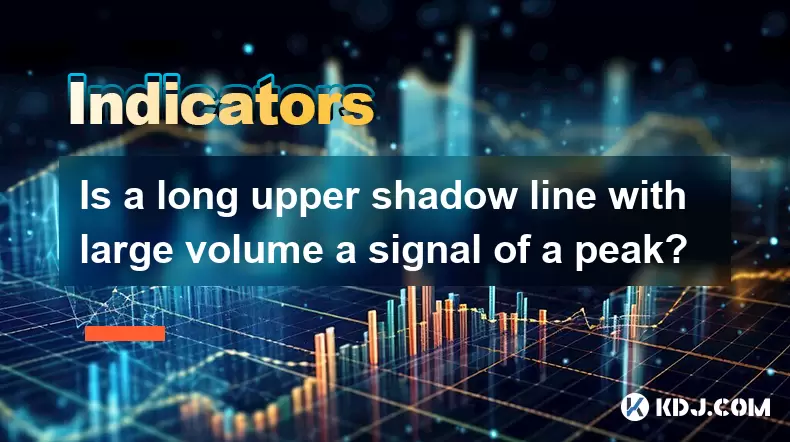
Is a long upper shadow line with large volume a signal of a peak?
Jun 17,2025 at 05:07am
Understanding the Long Upper Shadow LineA long upper shadow line, often referred to as a shooting star or inverted hammer depending on its location in a chart, is a candlestick pattern that indicates potential reversal from an uptrend. This pattern forms when prices rise significantly during the trading period but then fall back to close near the openin...

How to confirm the effectiveness of the average price line support in the time-sharing chart?
Jun 17,2025 at 12:56am
Understanding the Time-Sharing Chart and Its RelevanceIn cryptocurrency trading, time-sharing charts play a crucial role in analyzing short-term price movements. These charts typically display price fluctuations over a specific period, often ranging from minutes to hours. Traders rely on them to make quick decisions based on real-time data. The average ...
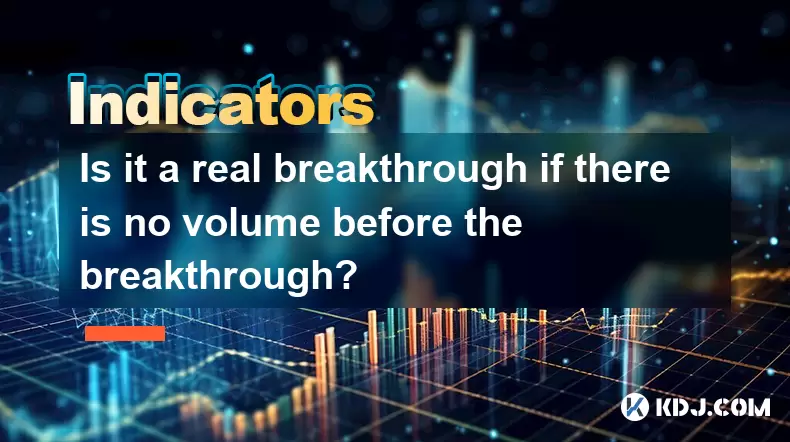
Is it a real breakthrough if there is no volume before the breakthrough?
Jun 17,2025 at 08:03am
Understanding the Concept of a Breakthrough in Cryptocurrency TradingIn cryptocurrency trading, a breakthrough typically refers to a price movement that surpasses a key resistance or support level. Traders often look for such events as potential signals for trend continuation or reversal. However, a crucial factor that determines the strength and reliab...

What does it mean when the momentum indicator breaks above the zero axis?
Jun 17,2025 at 12:43am
Understanding the Momentum IndicatorThe momentum indicator is a technical analysis tool used to measure the speed or velocity of price movements in cryptocurrency markets. It helps traders identify potential trend reversals, overbought or oversold conditions, and confirms existing trends. The indicator typically oscillates around a zero line, with value...
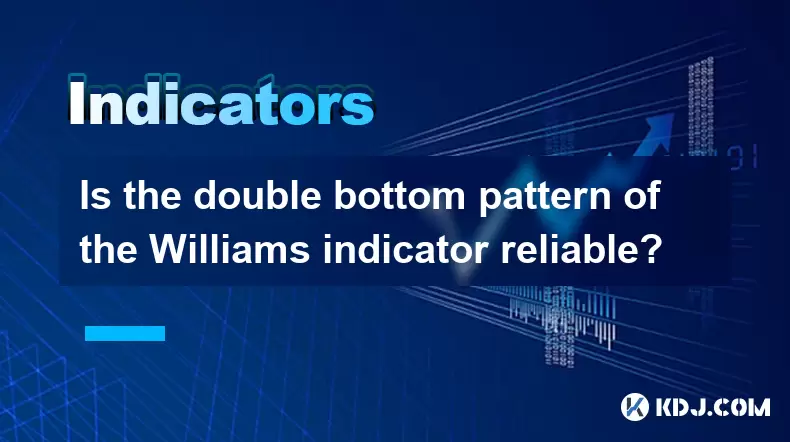
Is the double bottom pattern of the Williams indicator reliable?
Jun 17,2025 at 03:56am
Understanding the Williams Indicator and Its SignificanceThe Williams %R indicator, often referred to as Williams Percent Range, is a momentum oscillator used in technical analysis to identify overbought or oversold conditions in the market. Developed by Larry Williams, this indicator fluctuates between 0 and -100, with readings above -20 indicating ove...
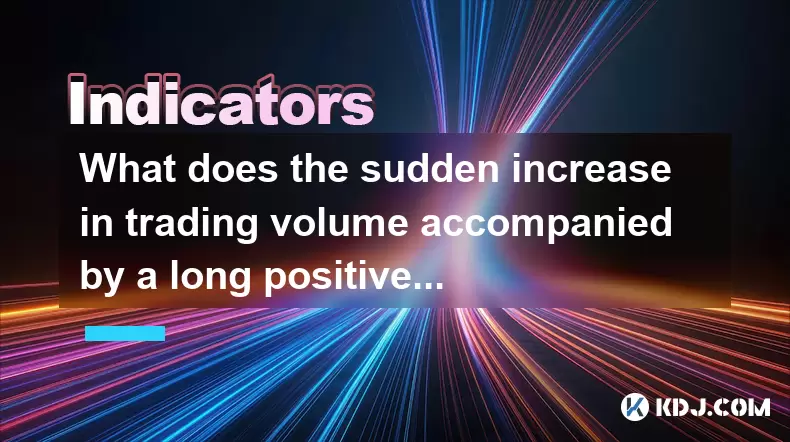
What does the sudden increase in trading volume accompanied by a long positive line mean?
Jun 17,2025 at 06:01am
Understanding the Sudden Surge in Trading VolumeWhen traders observe a sudden increase in trading volume, it typically signals a significant shift in market sentiment. This surge often indicates that more participants are entering or exiting positions, which could be due to news events, macroeconomic data releases, or institutional activity. High tradin...

Is a long upper shadow line with large volume a signal of a peak?
Jun 17,2025 at 05:07am
Understanding the Long Upper Shadow LineA long upper shadow line, often referred to as a shooting star or inverted hammer depending on its location in a chart, is a candlestick pattern that indicates potential reversal from an uptrend. This pattern forms when prices rise significantly during the trading period but then fall back to close near the openin...

How to confirm the effectiveness of the average price line support in the time-sharing chart?
Jun 17,2025 at 12:56am
Understanding the Time-Sharing Chart and Its RelevanceIn cryptocurrency trading, time-sharing charts play a crucial role in analyzing short-term price movements. These charts typically display price fluctuations over a specific period, often ranging from minutes to hours. Traders rely on them to make quick decisions based on real-time data. The average ...

Is it a real breakthrough if there is no volume before the breakthrough?
Jun 17,2025 at 08:03am
Understanding the Concept of a Breakthrough in Cryptocurrency TradingIn cryptocurrency trading, a breakthrough typically refers to a price movement that surpasses a key resistance or support level. Traders often look for such events as potential signals for trend continuation or reversal. However, a crucial factor that determines the strength and reliab...

What does it mean when the momentum indicator breaks above the zero axis?
Jun 17,2025 at 12:43am
Understanding the Momentum IndicatorThe momentum indicator is a technical analysis tool used to measure the speed or velocity of price movements in cryptocurrency markets. It helps traders identify potential trend reversals, overbought or oversold conditions, and confirms existing trends. The indicator typically oscillates around a zero line, with value...

Is the double bottom pattern of the Williams indicator reliable?
Jun 17,2025 at 03:56am
Understanding the Williams Indicator and Its SignificanceThe Williams %R indicator, often referred to as Williams Percent Range, is a momentum oscillator used in technical analysis to identify overbought or oversold conditions in the market. Developed by Larry Williams, this indicator fluctuates between 0 and -100, with readings above -20 indicating ove...

What does the sudden increase in trading volume accompanied by a long positive line mean?
Jun 17,2025 at 06:01am
Understanding the Sudden Surge in Trading VolumeWhen traders observe a sudden increase in trading volume, it typically signals a significant shift in market sentiment. This surge often indicates that more participants are entering or exiting positions, which could be due to news events, macroeconomic data releases, or institutional activity. High tradin...
See all articles

























































































